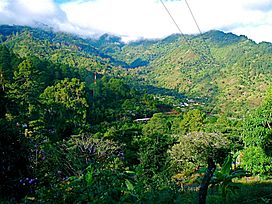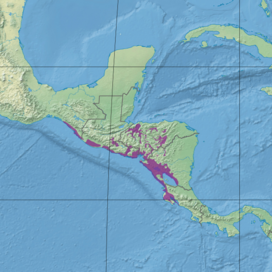Central American dry forests facts for kids
Quick facts for kids Central American dry forests |
|
|---|---|

Valley in La Tigra National Park
|
|

Ecoregion territory (in purple)
|
|
| Ecology | |
| Realm | Neotropical |
| Biome | tropical and subtropical dry broadleaf forests |
| Borders |
List
|
| Geography | |
| Area | 68,100 km2 (26,300 sq mi) |
| Countries | |
| Conservation | |
| Conservation status | Critical/Endangered |
| Protected | 6.75% |
The Central American dry forests are a special type of forest found in Central America. They are part of a larger group of forests called tropical and subtropical dry broadleaf forests. These forests are unique because they have a long dry season each year.
Contents
Where Are These Forests Found?
The Central American dry forests cover a huge area, about 68,100 square kilometers. That's like a really big state or country!
They stretch along the Pacific coast of Central America. You can find them starting in southern Chiapas, Mexico. From there, they go through Guatemala, El Salvador, Honduras, and Nicaragua. They end in the northeast part of Costa Rica.
You can also find smaller patches of these dry forests. These are hidden in valleys among the mountains of Central America. These forests grow from sea level up to about 800 meters high.
What's the Weather Like?
The climate in these forests is tropical. This means it's usually warm all year round.
The average rainfall is between 1000 and 2000 millimeters each year. But this rain doesn't fall evenly. There are usually 5 to 8 dry months every year. Sometimes there's one long dry period and one shorter one.
The mountains in Central America run from northwest to southeast. The wind usually blows from the northeast or east. This means the Pacific side of the mountains often gets less rain. It's like being in a "rain shadow". This is why these areas are drier than the Caribbean side.
Plants of the Dry Forest
The main type of plant life here is a low-growing dry forest. The tallest trees can reach up to 30 meters high. Below them, there are smaller trees, large bushes, and woody vines called lianas.
Most of the tall trees are deciduous. This means they lose their leaves during the dry season. Many of these trees belong to the bean family, called Fabaceae. They often have leaves made up of many smaller leaflets.
Some common tall trees in the southern part of these forests include Bombax ceiba, Bonellia macrocarpa (subspecies pungens), Calycophyllum candidissimum, Casearia arguta, Chomelia spinosa, Croton reflexifolius, Enterolobium cyclocarpum, Eugenia salamensis, Erythroxylum havanense, Guazuma ulmifolia, Handroanthus ochraceus, Tabebuia rosea, Thouinidium decandrum, Trichilia americana, and Zanthoxylum setulosum.
The smaller trees and bushes in the understory often stay green all year. Many of them have thorns. Plants from the Rubiaceae family are very common here.
There are at least 50 plant species that are found only in these dry forests. This means they are endemic to this area. Some plant groups, called genera, are also unique here. These include Myrospermum and Rehdera. Rehdera is only found in northern Guanacaste Province in Costa Rica.
Animals of the Dry Forest
Many amazing animals live in the Central American dry forests.
Mammals
Some of the native mammals you might find are:
- Jaguar (Felis onca)
- Puma (Puma concolor)
- Ocelot (Leopardus pardalis)
- Margay (Leopardus wiedii)
- Jaguarundi (Herpailurus yagouaroundi)
- Baird's tapir (Tapirus bairdii)
- Northern tamandua (Tamandua mexicana)
- Central American spider monkey (Ateles geoffroyi)
Birds
Several bird species are almost only found here, or have a very limited range. These include:
- White-bellied chachalaca (Ortalis leucogastra)
- Blue-tailed hummingbird (Saucerottia cyanura)
- Giant wren (Campylorhynchus chiapensis)
- Pacific parakeet (Psittacara strenuus)
Protecting These Forests
Sadly, a lot of these dry forests have been cut down. They are often turned into pastures for cows to graze. This is the main reason why these forests are disappearing.
Because of this, the World Wildlife Fund has ranked these forests as "critical/endangered". This means they are in serious danger and need help.
About 6.75% of the Central American dry forests are in protected areas. These special places help keep the forests safe. Some of these protected areas include:
- Agalta National Park, Honduras
- Azul Meámbar National Park, Honduras
- Barra Honda National Park, Costa Rica
- Carara National Park, Costa Rica
- El Imposible National Park, El Salvador
- Guanacaste National Park, Costa Rica
- La Tigra National Park, Honduras
- Las Baulas de Guanacaste Marine National Park, Costa Rica
- Montaña de Botaderos Carlos Escaleras Mejía National Park, Honduras
- Montaña de Comayagua National Park, Honduras
- Palo Verde National Park, Costa Rica
- Pico Bonito National Park, Honduras
- Pico Píjol National Park, Honduras
- San Diego and San Felipe Las Barras National Park, El Salvador
- Santa Bárbara National Park, Honduras
- Santa Rosa National Park, Costa Rica
- Sipacate-Naranjo National Park, Guatemala
See also
 In Spanish: Bosques secos de América Central para niños
In Spanish: Bosques secos de América Central para niños
- List of ecoregions in Mexico
- List of ecoregions in Guatemala
- Ecoregions of Central America
- ecoregions of the Tropical and subtropical dry broadleaf forests biome

